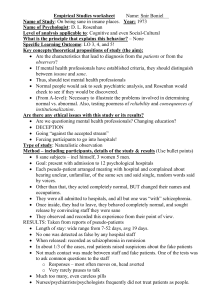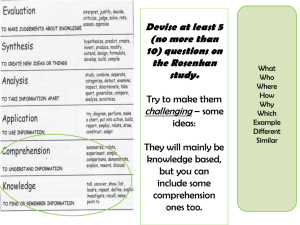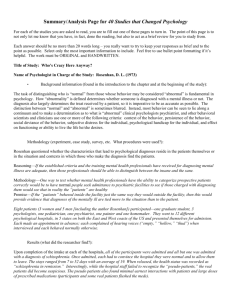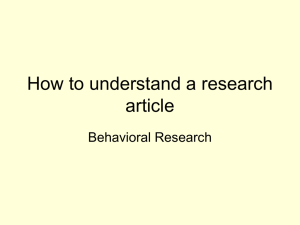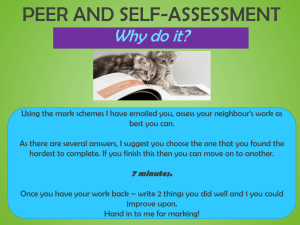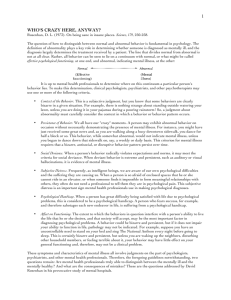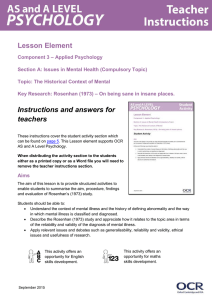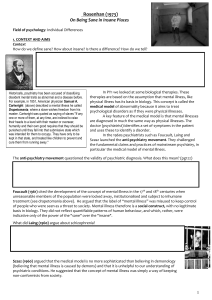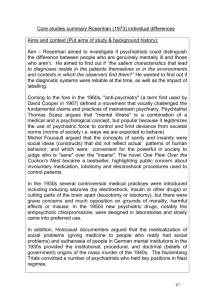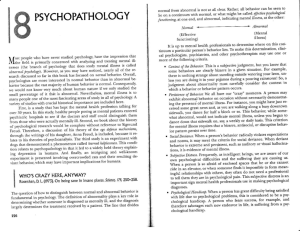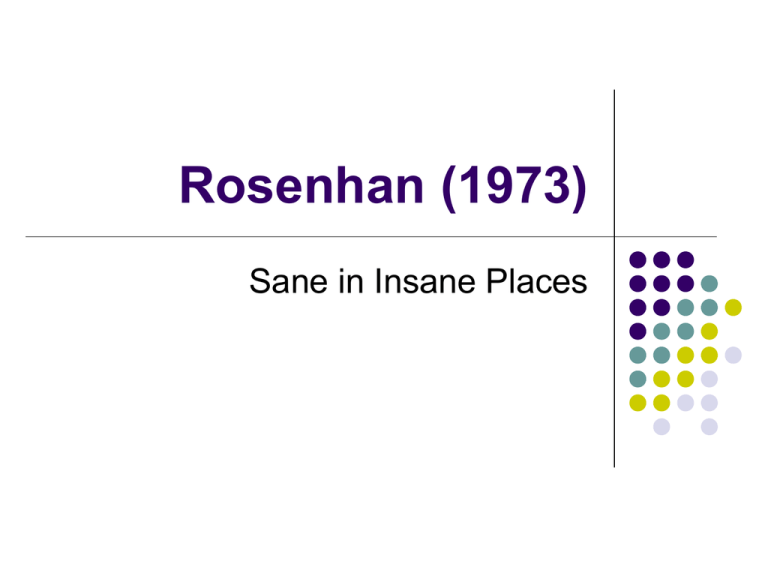
Rosenhan (1973)
Sane in Insane Places
Map to Spec – Page 61
4. Studies in detail
a) Describe and evaluate Rosenhan (1973)
“On being sane in insane places”
Map to Spec – Page 59
3. Content
c) Using the findings of studies, describe and
evaluate reliability, validity and cultural issues
with regard to the diagnosis of disorders
(including use of Diagnostic and Statistical
Manual (DSM)).
"If sanity and insanity exist, how
shall we know them?"
In other words….
Do the characteristics of abnormality reside in
the patients?
or
In the environments in which they are
observed?
Does madness lie in the eye of the observer?
Background
A long history of attempting to classify abnormal
behavior.
Most commonly accepted approach to understanding &
classifying abnormal behavior is the medical model.
Psychiatry
Psychiatrists are medical doctors and regard mental
illness as another kind of illness (in addition to
physical)
Beginning in the 1950s the medical model has used the
Diagnostic and Statistical Manual of Mental Disorders
(DSM) to classify abnormal behavior
The Medical Model
Assumes that
psychological
disorders are
mental illnesses
that need to be
diagnosed &
treated through
therapy or
medication
DSM-IV-TR
The Diagnostic and
Statistical Manual of
Mental Disorders
provides an
authoritative
classification
scheme.
Describes disorders
and their prevalence
without presuming to
explain their causes
Labels
Although diagnostic labels may
facilitate communication and
research, they can also bias our
perception of people’s past and
present behavior and unfairly
stigmatize these individuals.
Background
1960s - The anti-psychiatry movement (psychiatrists
& psychotherapists) began to criticize the medical
model
Rosenhan was also a critic of the medical model –
“Its a worrying thought that there could be
thousands of people stuck in institutes that are just
as ‘sane’ as we are.”
His study can be seen as an attempt to demonstrate
that psychiatric classification is unreliable
Background
Difficulty of judging what is 'normal'
Varies over time / between societies
Rosenhan asked "If sanity and insanity
exist, how shall we know them?"
Research Q: if 'normal' people attempt
admission to psychiatric hospitals, will they
be detected? / how?
Aim
Test the hypothesis that psychiatrists cannot
reliably tell the difference between people
who are sane and those who are insane.
The Researchers
Confederates (not the subjects)
EIGHT sane people!
Three women and five men
One graduate student
Three psychologists
One pediatrician
A painter
A housewife
A psychiatrist
Procedures
Telephoned 12 psychiatric hospitals for
urgent appointment (5 US states)
Arrived at admissions
Gave false names and occupations
Gave other ‘life’ details correctly
So here’s my
cunning plan. I’m
going to send
these people to a
hospital and see
what happens if
they say they’ve
got symptoms of
madness.
o
What
symptom
could they
use?
o
And why?
They said their only
symptom was hearing a
voice, the same sex as
they are, saying the
following:
Empty
Thud
Hollow
Procedures
Complained that they had been
hearing voices
Unfamiliar and the same sex as
themselves
Said 'empty', 'hollow', 'thud'.
Symptoms were partly chosen
because they were similar to
existential crisis symptoms (Who
am I? What is it all for? –
meaninglessness of one’s life)
Also chosen because
there is no mention of
existential psychosis
in the literature.
Did they get let in?
All were admitted to hospital
All but one were diagnosed as suffering
from schizophrenia
Once admitted the ‘pseudo-patients’
stopped simulating ANY symptoms
Took part in ward activities
Procedures
Kept notes on their
experiences
Did this secretly to begin
with
Then openly when they
realised no one cared or
paid any attention to them
doing this
Findings
The pseudo-patients were never detected
All pseudo-patients wished to be discharged
immediately
BUT - they waited until they were diagnosed
as “fit to be discharged”
How did the staff perceive them?
-
-
-
Normal behavior was misinterpreted:
Writing notes described as -“The patient engaged in
compulsive writing behavior”
Arriving early for lunch described as - “oral acquisitive
syndrome”
Outburst from patient – never enquire what caused
response
Behavior distorted to ‘fit in’ with
diagnosis/label
4 of the pseudo-patients carried out an
observation on how patients were
treated by staff…..
The pseudo-patients observations
If patients approached staff with simple
requests (NURSES & ATTENDANTS)
88% ignored them (walked away with head
averted)
10% made eye contact
2% stopped for a chat
(1283 attempts)
The pseudo-patient’s observations
If they approached staff with simple
requests (PSYCHIATRISTS)
71% ignored them (walked away with
head averted)
23% made eye contact
2% stopped for a chat
(185 attempts)
Observations
Nurses stayed in
ward offices 90% of
time
Each ‘real patient’
spent less than 7
minutes per day
with psychiatric staff
Powerlessness and Depersonalization
Medical records were open to all staff regardless of
status or therapeutic relationship with the patient
Personal hygiene monitored
Many of the toilets did not have doors
Some of the ward orderlies were brutal to patients in
front of other patients ~ would stop when another
staff member approached
This indicated that staff were credible witnesses but
patients were not
How long did they stay in
hospital?
The shortest stay was 7 days
The longest stay was 52 days
The average stay was 19 days
They had agreed to stay until they convinced the
staff they were sane!!
Were they treated in the same
way as normal patients...
Given total of 2100 medication tablets
They flushed them down the loos
Noted that other patients did the same and that
this was ignored as long as patients behaved
themselves !!
Did anyone suspect?
35
out of 118 patients voiced
suspicions about the pseudopatients
- “You’re not crazy”,
- “You’re a journalist”,
-“You’re a professor,
checking up on the
hospital”
On Release
The pseudo-patients were diagnosed with
Schizophrenia “IN REMISSION”
So…
Lack of monitoring
Distortion of behavior
Lack of normal interaction
Powerlessness & depersonalization
Alice In Wonderland
"But I don't want to go among
mad people," Alice remarked.
"Oh, you can't help that," said
the Cat: "we're all mad here.
I'm mad. You're mad.“
"How do you know I'm mad?"
said Alice.
"You must be," said the Cat, "or
you wouldn't have come
here."
Summarise
What was the IV for this experiment?
What was the DV for this experiment?
What was the experimental method
used?
Rosenhan:
The follow up study…
A teaching & research hospital heard
of the first study – didn’t think they
would make the same mistake
They were warned that …
Over the next three months ONE OR
MORE pseudo-patient would attempt
to be admitted
What happened……….?
Staff members rated ‘new patients’ on scale
1 - 10 as ‘how likely to be a fraud’
193 patients ‘assessed’
41 rated as a pseudo-patient (by staff)
23 rated as pseudo-patient (by psychiatrist)
19 rated as pseudo-patient (by both)
AH HA HA HA!
Just guess how many
I’d really sent.......
How many of these SUSPECTS
were pseudo-patients?……...
NONE
No pseudo-patients were
sent
Staff were rating their regular intake
Summarise
What was the IV in this study?
What was the DV in this study?
What did Rosenhan conclude?
Remember, his question was …
Do the characteristics of abnormality reside in
the patients?
OR
In the environments in which they are
observed?
Does madness lie in the eye of the observer?
Rosenhan’s conclusion…..
“It is clear that we are unable to distinguish the
sane from the insane in psychiatric hospitals”
In the first study - We are unable to detect ‘sanity’
This is what’s known as a Type II error – diagnosing
healthy people as sick
In the follow up study - We are unable to detect ‘insanity’
This is what’s known as a Type I error – diagnosing sick
people as healthy
Rosenhan’s study highlighted:
The depersonalisation and
powerlessness of patients in psychiatric
hospitals
That behaviour is interpreted according
to expectations of staff and that these
expectations are created by the labels
SANITY & INSANITY
Another Rosenhan note……..
The pseudo-patients described their stay
in the hospitals as a negative
experience
This is not to say that REAL patients
have similar experiences
Real patients do not know the diagnosis
is false & are NOT pretending
Your Task
Complete Dominoes activity in your groups –
first to do it wins!
Your Task
Exam conditions – past exam questions on
methodology and findings of Rosenhan’s
study
Peer mark using mark scheme provided
Your Task
Evaluate the study! In your groups consider
one issue (G R A V E)
How can the study be evaluated in terms of
this issue?
Are there strengths? Weaknesses? Both?

